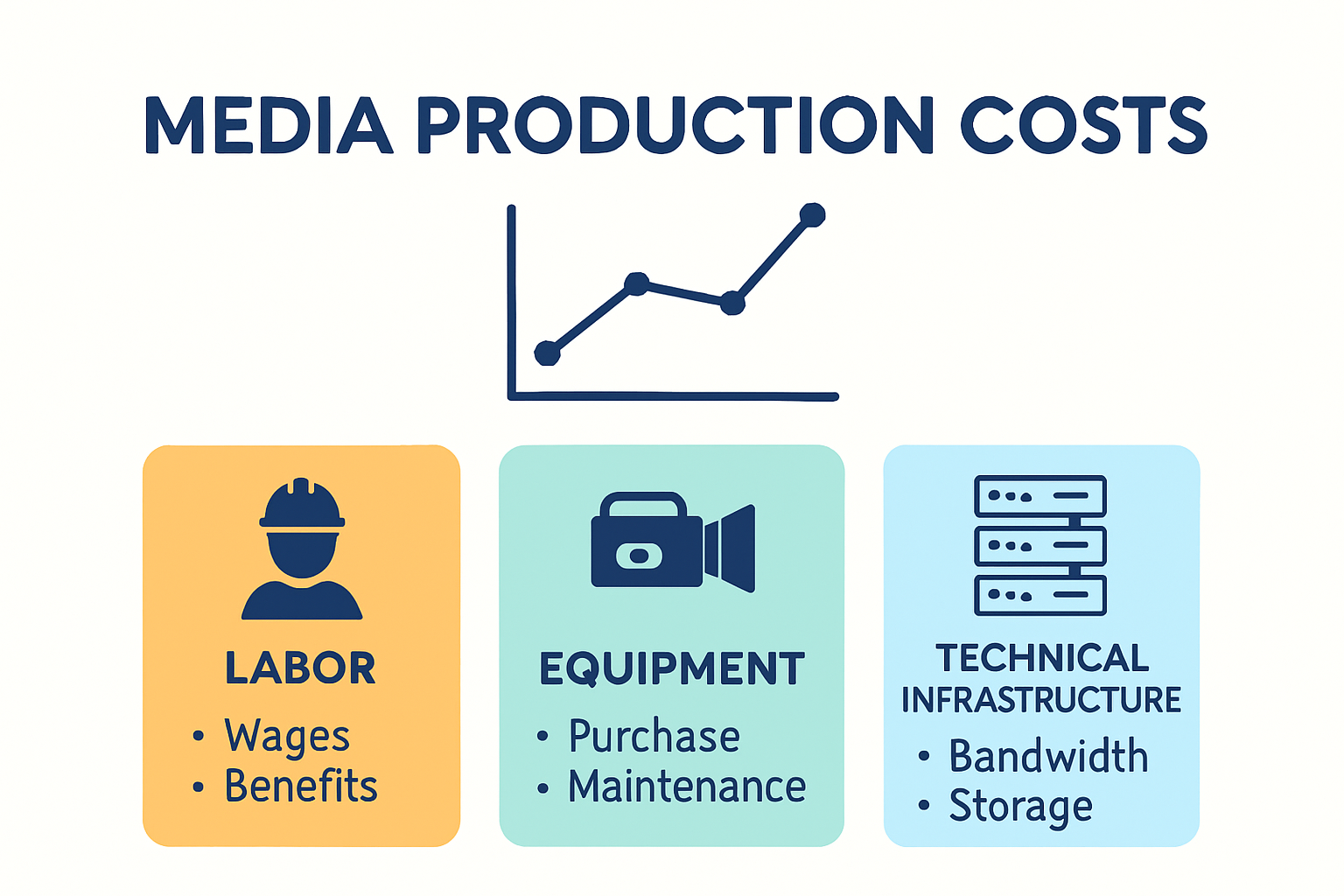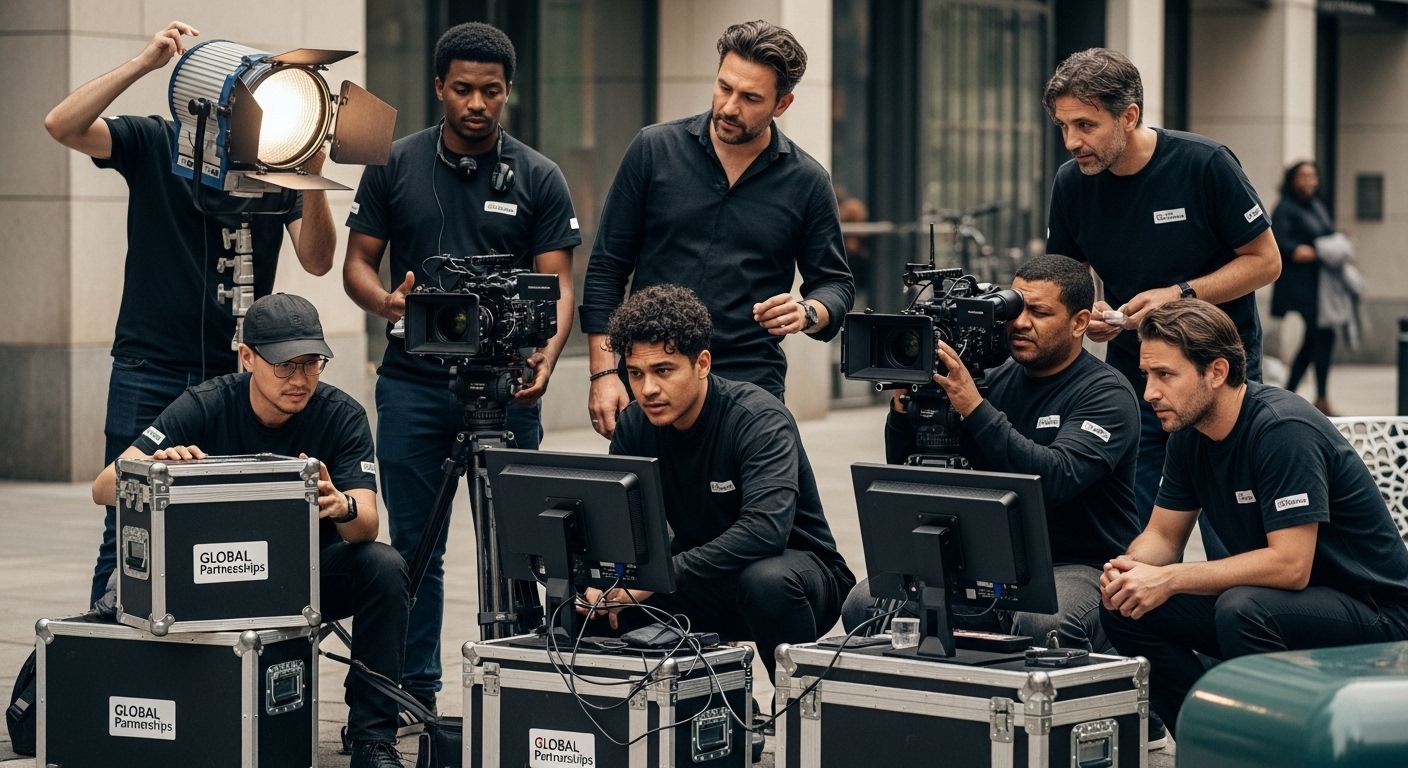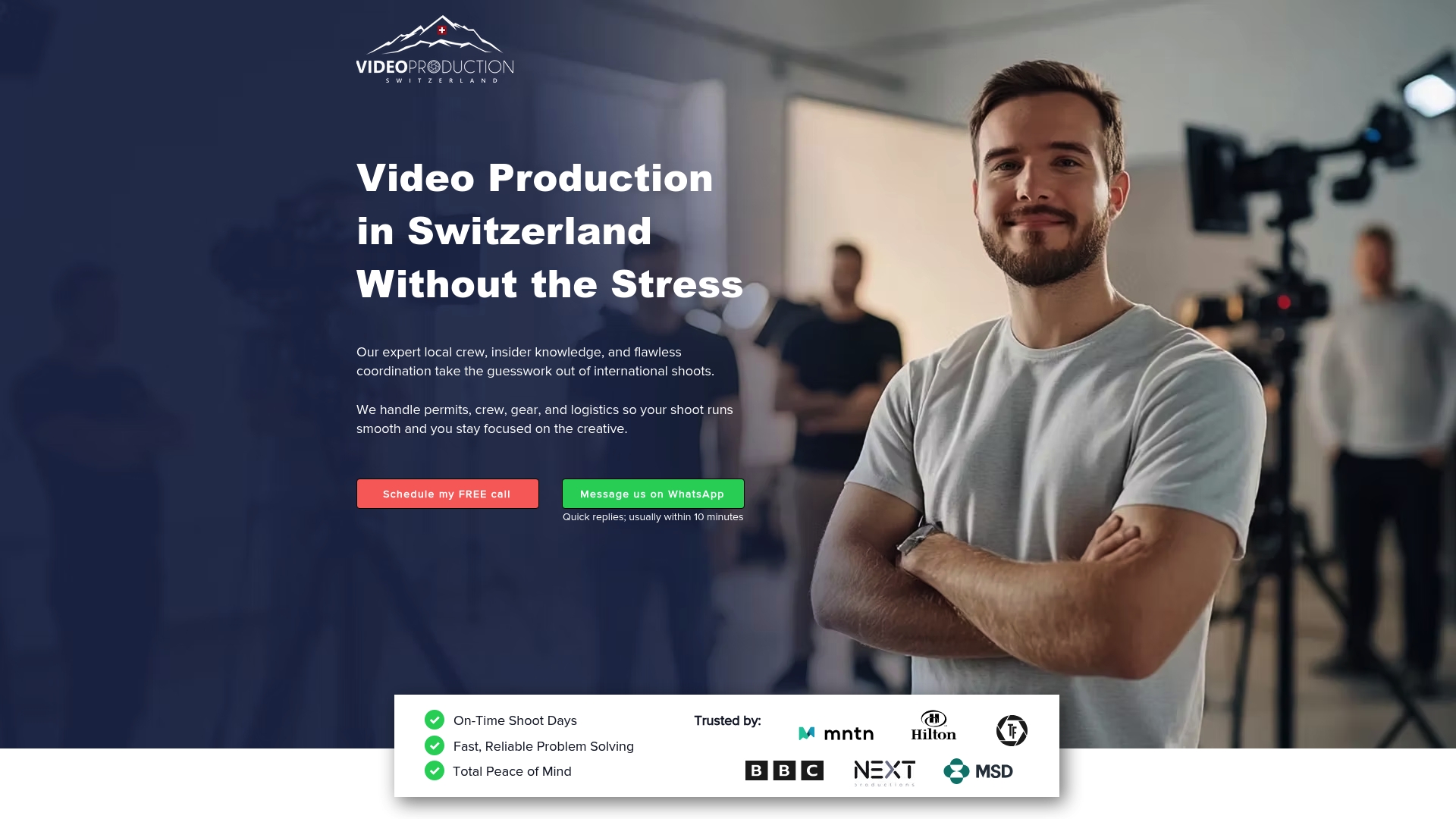Minimizing Production Costs: Smart Strategies for Media Teams
- info1419758
- Aug 18
- 10 min read

Every media team worries about squeezing the most value from their production budgets. Equipment investments, travel, and personnel add up so fast that even experienced producers get blindsided. Yet, here’s a surprise. Cloud technology now cuts service costs by as much as 22 percent, just by shifting how your team stores and manages files. But that’s only one piece. The biggest savings actually come from decisions made long before the cameras roll—where resource planning and global partnerships can reshape the bottom line in ways you would never expect.
Table of Contents
Quick Summary
Takeaway | Explanation |
Understand cost drivers to optimize budgets | Identifying key components like labor and equipment can help streamline financial planning for media projects. |
Strategically allocate personnel for efficiency | Matching team skills to project needs maximizes productivity and reduces unnecessary costs. |
Invest in technology to enhance workflows | Utilizing modern digital tools can lower operational expenses and improve production quality significantly. |
Build global partnerships for resource sharing | Collaborating internationally allows access to diverse resources and expertise, reducing production costs. |
Focus on robust preproduction planning | Detailed foresight in resource allocation helps identify potential challenges and ensures project success. |
Understanding Key Drivers of Production Costs
Media production teams operate in a complex financial landscape where understanding cost drivers is crucial for maintaining project profitability and operational efficiency. Production costs are not simply a matter of equipment and personnel expenses but involve a nuanced interplay of multiple interconnected factors.
Labor and Human Resource Expenses
Perhaps the most significant driver of production costs is human resources. According to the U.S. Bureau of Labor Statistics, producers and directors frequently face intense pressure to complete projects within strict budgetary constraints. These professionals must balance creative vision with financial realities, recognizing that workdays can be irregular and often extend to evenings, weekends, and holidays.
Skilled professionals command higher rates, and the complexity of media production requires specialized talent across multiple domains. Crew composition significantly impacts overall expenses, with roles like cinematographers, sound engineers, lighting technicians, and post-production specialists each contributing to the total budget. Strategic workforce planning becomes essential in minimizing production costs without compromising quality.
Technical Infrastructure and Equipment Investment
Technical infrastructure represents another critical cost driver in media production. Research from the Motion Picture Association reveals that the industry supports millions of jobs annually, with significant economic investments in technological resources. Modern production requires sophisticated equipment like high-resolution cameras, advanced lighting systems, professional audio recording gear, and powerful editing workstations.
While cutting-edge technology can dramatically enhance production quality, it also introduces substantial financial considerations. Media teams must carefully evaluate equipment needs, considering factors like rental versus purchase costs, maintenance expenses, and technological obsolescence. Learn more about strategic production planning to optimize your technical resource allocation.
Operational and Logistical Expenses
Beyond direct labor and equipment costs, media productions incur numerous operational expenses that can quickly escalate budgets. Location fees, transportation logistics, permit acquisitions, insurance coverage, and post-production processing all contribute to the financial complexity of media projects.
Geographic considerations play a significant role in cost management. Shooting in different environments requires careful planning to mitigate unexpected expenses. Travel costs, local permit requirements, accommodation for crew members, and regional equipment rental rates can vary dramatically, necessitating meticulous financial forecasting.
Understanding these key drivers allows media teams to develop more precise budgeting strategies. By analyzing each cost component systematically, production managers can identify potential optimization opportunities, implement cost-control measures, and ultimately deliver high-quality content while maintaining financial sustainability.
To help readers quickly compare the main cost drivers in media production, the table below summarizes the key aspects and considerations for each primary driver discussed in the article.
Cost Driver | Key Aspects | Considerations for Media Teams |
Labor & Human Resource Expenses | Specialized talent, crew composition, variable schedules | Strategic workforce planning, balancing creative needs with cost |
Technical Infrastructure & Equipment Investment | High-end cameras, lighting, audio, editing workstations | Rental vs. purchase, maintenance, obsolescence, shared resources |
Operational & Logistical Expenses | Location, travel, permits, insurance, post-production | Geographic differences, thorough financial forecasting, planning for contingencies |

Successful minimizing production costs is not about reducing quality but about making intelligent, strategic decisions that maximize available resources and create efficient workflows.
Efficient Resource Allocation in Video Projects
Efficient resource allocation stands as a critical strategy for media teams seeking to optimize production workflows and control costs. The ability to strategically distribute human capital, technological assets, and financial resources can dramatically impact a project’s overall success and profitability.
Strategic Personnel Management
Personnel represent one of the most significant resources in video production. Research from project management experts highlights the importance of developing sophisticated allocation models that consider individual team members’ skills, learning curves, and potential productivity. Media teams must look beyond simple task assignment and focus on creating dynamic workforce strategies that maximize individual strengths.
This approach involves carefully mapping team capabilities against project requirements. By understanding each team member’s unique skill set, managers can create more efficient work distributions. For instance, a cinematographer with specialized experience in low-light environments might be strategically assigned to challenging shooting conditions, while a post-production specialist with advanced color grading skills could be positioned to enhance the final visual quality.
Technology and Equipment Optimization
Technological resources demand equally sophisticated allocation strategies. Instructional video production research suggests that long-term usability and resource efficiency can be significantly improved through strategic equipment planning. This means moving beyond simple rental or purchase decisions and developing comprehensive technological deployment strategies.
Key considerations include equipment versatility, maintenance costs, and potential multi-project utilization. High-end cameras, lighting systems, and audio equipment represent substantial investments. Media teams can maximize these investments by creating shared resource pools, implementing robust maintenance schedules, and carefully tracking equipment usage across multiple projects. Learn more about planning your video shoot to understand how strategic equipment allocation can transform production efficiency.
Preproduction Planning and Resource Forecasting
Preproduction represents the most critical phase for efficient resource allocation. Academic studies in video production emphasize the importance of comprehensive lesson design and storyboarding as fundamental strategies for optimizing resource deployment. This approach allows teams to anticipate potential challenges, identify resource requirements, and develop precise allocation strategies before actual production begins.
Effective resource forecasting involves detailed scenario planning. Teams must develop flexible frameworks that can adapt to changing project requirements while maintaining core efficiency metrics. This might include creating buffer resources for unexpected challenges, developing cross-training programs to increase team versatility, and implementing robust tracking mechanisms to monitor resource utilization in real-time.
Ultimately, efficient resource allocation is not about strict cost-cutting but about creating intelligent, adaptive systems that maximize productivity. By combining strategic personnel management, technological optimization, and comprehensive preproduction planning, media teams can transform resource allocation from a administrative task into a powerful competitive advantage.
Leveraging Technology to Streamline Expenses
Technology has become a pivotal tool for media teams seeking to optimize production expenses and enhance operational efficiency. By strategically implementing digital solutions, organizations can dramatically reduce costs while simultaneously improving overall production quality and workflow management.
Digital Workflow Optimization
Research from digital content experts highlights the transformative potential of digital tools in reducing operational expenses. Modern media teams can leverage cloud-based platforms and collaborative technologies to streamline production processes, eliminate redundant tasks, and create more agile working environments.
Cloud computing represents a particularly powerful strategy for cost reduction. Cloud technology research indicates that organizations can decrease service costs by up to 22% through intelligent storage and virtual machine management. This approach allows media teams to scale resources dynamically, paying only for the computational power and storage they actually utilize.
Automation and Efficiency Tools
Instructional video production studies recommend implementing technological solutions that standardize and accelerate content creation processes. Automation tools can significantly reduce manual labor costs by handling repetitive tasks such as video editing, metadata generation, and content formatting.
Key technological interventions include:
Automated editing software that can quickly process raw footage
AI-powered transcription services for rapid captioning
Project management platforms that track resources and timelines
These tools not only reduce direct labor costs but also minimize human error and increase overall production consistency. Learn more about strategic video production planning to understand how technology can transform your workflow.
The following table organizes the key technologies and digital solutions discussed, highlighting their main functions and the cost-saving benefits they offer to media teams.
Technology or Tool | Main Function | Cost-Saving Benefit |
Cloud storage & virtual machines | Dynamic, scalable resource allocation | Reduces service costs by up to 22% |
Automated editing software | Processes raw footage quickly | Lowers manual labor, increases editing speed |
AI-powered transcription | Rapid caption and script creation | Reduces labor/time needed for transcription |
Project management platforms | Tracks resources and timelines | Prevents overruns, improves team efficiency |
Strategic Technology Investment
Successful technology integration requires a nuanced approach beyond simple cost-cutting. Media teams must view technological investments as strategic opportunities for long-term efficiency. This means carefully evaluating tools based on their potential to improve productivity, reduce recurring expenses, and enhance overall production quality.
Implementing a robust technology strategy involves continuous assessment and adaptation. Teams should regularly audit their technological infrastructure, identifying outdated systems and exploring emerging solutions that offer better performance and cost-effectiveness. This might include transitioning from legacy software to more flexible, cloud-native alternatives or investing in modular technologies that can easily integrate with existing workflows.
By approaching technology as a strategic asset rather than merely an expense, media teams can create more resilient, adaptable production environments. The goal is not just to reduce costs but to build more intelligent, responsive operational frameworks that can quickly adjust to changing market demands and technological innovations.
Ultimately, leveraging technology is about creating a holistic ecosystem where digital tools work seamlessly to enhance human creativity, streamline processes, and optimize resource allocation. When implemented thoughtfully, technology becomes a powerful catalyst for innovation and cost management in media production.
Building Global Partnerships for Cost Savings
In an increasingly interconnected media landscape, building strategic global partnerships has emerged as a powerful mechanism for minimizing production costs and expanding creative capabilities. These collaborative relationships enable media teams to leverage diverse resources, share technological expertise, and create more cost-effective production ecosystems.
Strategic International Collaboration
Research from the National Defense University demonstrates that international partnerships can generate substantial operational efficiencies by bypassing traditional bureaucratic barriers. For media production teams, this translates into opportunities to access global talent pools, share specialized equipment, and distribute production expenses across multiple stakeholders.
International collaborations offer nuanced advantages beyond mere cost reduction. By forming strategic alliances with production houses, technology providers, and creative professionals across different regions, media teams can access unique local insights, cultural perspectives, and production capabilities that would be prohibitively expensive to develop independently.
Financial and Resource Optimization
Research from the Brookings Institution introduces innovative concepts like ‘virtual funds’ that can be applied to media production partnerships. These collaborative financial models allow organizations to track contributions dynamically, creating more flexible and transparent resource allocation mechanisms.
Key strategies for optimizing global partnerships include:
Cross-border equipment sharing to reduce individual capital investments
Talent exchange programs that enable skill development and resource optimization
Collaborative production planning to maximize technological and creative synergies
Learn more about international production planning to understand how strategic global connections can transform your media production approach.
Technology and Knowledge Transfer
Successful global partnerships extend beyond financial considerations, focusing on comprehensive knowledge and technology transfer. Media teams can create mutually beneficial ecosystems where technological expertise, creative methodologies, and production innovations are shared across international boundaries.
This approach requires developing robust communication infrastructures, establishing clear collaboration protocols, and creating flexible frameworks that accommodate diverse cultural and operational contexts. By treating partnerships as dynamic, evolving relationships rather than transactional agreements, media teams can unlock unprecedented opportunities for innovation and cost optimization.
Understanding cultural nuances, maintaining transparent communication, and developing mutual trust become as important as the financial metrics. Successful global partnerships are built on reciprocal value creation, where each participant gains unique advantages that transcend immediate monetary considerations.
Ultimately, building global partnerships represents a sophisticated approach to minimizing production costs. It transforms traditional cost-cutting strategies into dynamic, collaborative networks that generate value through shared resources, collective intelligence, and innovative cross-border thinking.

Frequently Asked Questions
What are the key drivers of production costs in media projects?
The main drivers of production costs include labor and human resource expenses, technical infrastructure and equipment investment, and operational and logistical expenses. Understanding these factors helps teams optimize their budgets effectively.
How can media teams optimize resource allocation to minimize costs?
Efficient resource allocation can be achieved through strategic personnel management by matching team members’ skills to project needs, optimizing technology and equipment usage, and thorough preproduction planning and resource forecasting to anticipate challenges.
What role does technology play in reducing production costs?
Technology helps streamline production processes through digital workflow optimization, automation tools, and strategic investments in advanced equipment. Cloud technologies, for instance, can reduce operational expenses significantly by providing scalable solutions.
How can global partnerships contribute to cost savings in media production?
Building global partnerships allows media teams to share resources, access diverse talent pools, and collaborate on international projects, leading to reduced individual costs and enhanced creative capabilities.
Discover Seamless Solutions for Smarter Production Cost Management
Struggling to balance production quality with tight budgets, rising operational expenses, and unpredictable local logistics? The article on minimizing production costs reveals that human resources, equipment rentals, and logistical headaches can quickly drain project funds, especially for international teams. Without local expertise, you risk expensive mistakes and delays in Switzerland.

Let us help you turn smart strategies into actual results. With over 20 years of experience, Video Production Switzerland handles every aspect of shoot management, so your crew can focus on creativity instead of permits, gear, or transport. Ready to control your costs and unlock smooth, reliable execution? Start with a free consultation at our service overview, or explore our full process for planning your video shoot. Contact us today to secure your production slot and experience production support that truly minimizes surprises.
Recommended

Comments